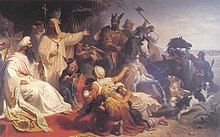User:DocKaar
The Graeco-Arabic Translation Movement was brought upon by the philosophies of the Golden Age of Islam under the Abbasid dynasty. Beginning in the second half of the eighth century with the accession of the Abbasid caliphate, the movement primarily was spurred on by the House of Wisdom in Baghdad and would last for over two hundred years. Among advancements in technology and mathematics, the Translation Movement also expanded philosophical ideas and beliefs through translations of ancient Greek and Syriac texts.[1] The movement paved way for a great deal of unique research by the Islamicate, who used the translated texts as a platform for new scientific developments in various fields like mathematics, medicine, philosophy, and physics.

House of Wisdom[edit]
Scholars came from all over the Islamic world to the Abbasid capital of Baghdad, which made the city an ideal place to be a center of cultural and scientific expansion. The Abbasids noticed this and, beginning with Harun Al-Rashid, became patrons of literary research.[2] The House of Wisdom saw its greatest patronage under the rule of al-Ma’Mun (r. 813-833). Engineers, architects, and scientists from all over the Abbasid empire flocked to Baghdad to study old literary works. Al-Ma’Mun would enlist and send out collectors to bring more foreign books into the city for translation and a free-flowing system of thought and ideas [2]. This was not a special niche project of private, wealthy benefactors, but the work of an entire civilization.[3]
While the House of Wisdom, or Bayt al-Hikmah, supposedly began as an exclusive library of personal Abbasid Caliph collections, it soon became a bustling public academy for new developments in fields such as astronomy, mathematics, and philosophy, and medicine[1]. Originally dubbed the “Storehouse of Wisdom” for its collection and preservation of ancient texts and poems, the House of Wisdom served as the centerpiece of Islamic scientific expansion from the 8th century until its destruction at the hands of the Mongols in 1258.[4] However, the progress made by the work of scholars in the House of Wisdom had already provided a critical service, spreading Greek ideas throughout the Middle East and allowing for original research to eclipse the knowledge of thinkers of old. While the House of Wisdom flourished under the Mu’tazelite rule of al-Ma’mun, other caliphs who succeeded him did not buy into the idea of the House of Wisdom.[3] According to al-Mutawakkil (r. 847–861), many of the fields and discussions at the House went against the Quran and Islamic law. Nevertheless, the contributions from the House of Wisdom spurred forward an Islamic Golden Age and brought innovative ideas to the Islamic and Western worlds.
Foreign Works[edit]
What began as a translation of few select Greek and Syriac texts from renowned authors such as Aristotle or Ptolemy expanded to multiple translations of many Greek works.[5] Translations were not done once and then forgotten. Works were commonly translated multiple times and revised to be as accurate as possible.[5] As new discoveries were made, the meaning of much of the old Greek translated text would be slightly altered. Abbasid science was became more strict with its measurements and methodologies as technology and science advanced, so it was crucial that all foreign texts were converted to Arabic in the most accurate way.

Many of the most notable Arabic philosophers were directly inspired by the teachings of Greek figures.[6] One of the most renowned translators of the Translation Movement, Ibn Rushd, wrote three separate translations of Aristotle’s Metaphysics: a short summary, a medium commentary, and a long, thought out analysis detailing each sentence Aristotle wrote.[6] This gave Aristotle’s ideas the ability to be read by all and appeal to casual, curious thinkers or dedicated scholars. The medical work of Galen, composed of 129 pieces was also fully fielded to Arabic by Arab Christian Hunayn ibn Ishaq, providing vast medical insight that had not been utilized in centuries.[6]
End of the Arabic Translation Movement[edit]
Periods of fierce Mongol Invasions in the 13th century saw the end of the Islamic Golden Age, and in turn the Arabic Translation Movement. In 1258 AD, the city of Baghdad was sieged and sacked by Il-khanate Mongol forces.[3] The priceless House of Wisdom, containing centuries of knowledge in fields from mathematics to astronomy, was looted and destroyed.
Legacy[edit]
The Arabic Translation Movement is responsible for much of the current knowledge of ancient Greek science and philosophy. With all the classical knowledge of the world in one place, it set the stage for a boom of advancements, such as the creation of algebra and the evolution of the scientific method.[2] The Western world curated many of the Greek ideas we know today from Arabic translations of the original copies. Hundreds of works from renowned Greek authors like Euclid or Archimedes would not be known as they are today without the work of scholars and academics during the Golden Age of Islam.
References[edit]
- ^ a b Pormann, Peter; Savage-Smith, Emilee (2007). Medieval Islamic medicine. Georgetown University Press. pp. 20–29. ISBN 9781589011618.
{{cite book}}:|access-date=requires|url=(help) - ^ a b c Brentes, Sonja; Morrison, Robert (2010). [ttps://doi.org/10.1017/CHOL9780521838245.024 "The sciences in Islamic societies (750–1800)"]. The New Cambridge History of Islam. 4: 560–570. doi:10.1017/CHOL9780521838245.024. Retrieved 10 November 2018.
- ^ a b c Lyons, Johnathan (2009). The house of wisdom : how the Arabs transformed Western civilization (1st U.S. ed.). New York: Bloomsbury Press. ISBN 9781596914599. Retrieved 10 November 2018.
- ^ Frazier, Ian (18 April 2005). "Invaders". The New Yorker. No. 2005. Annals of History. Retrieved 10 November 2018.
- ^ a b Gutas, Dimitri (1998). Greek thought, Arabic culture : the Graeco-Arabic translation movement in Baghdad and early ʻAbbāsid society (2nd-4th/8th-10th centuries). Routledge. pp. 50–58. ISBN 978-0-415-06132-2. Retrieved 10 November 2018.
- ^ a b c Khalidi, Hala; Dajani, Basma Ahmad Sedki (October 2015). "Facets from the Translation Movement in Classic Arab Culture". Procedia - Social and Behavioral Sciences. 205: 569–576. doi:10.1016/j.sbspro.2015.09.080. Retrieved 10 November 2018.
